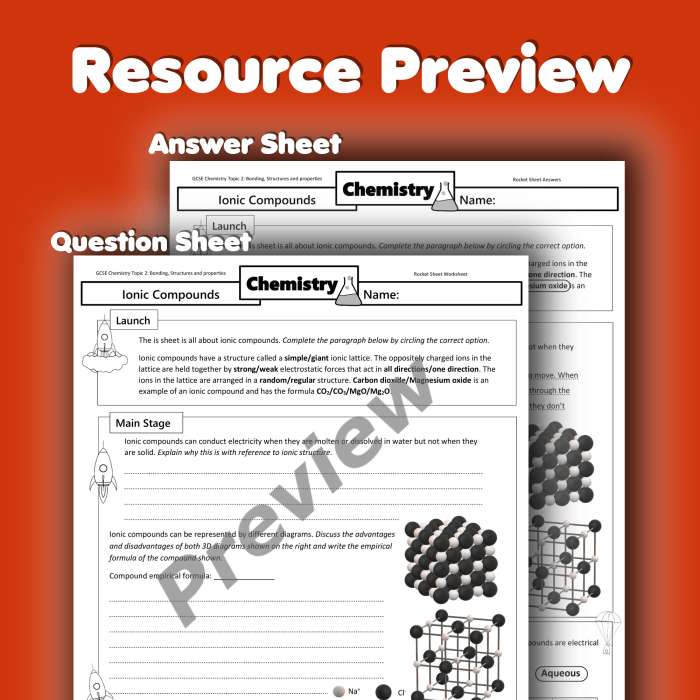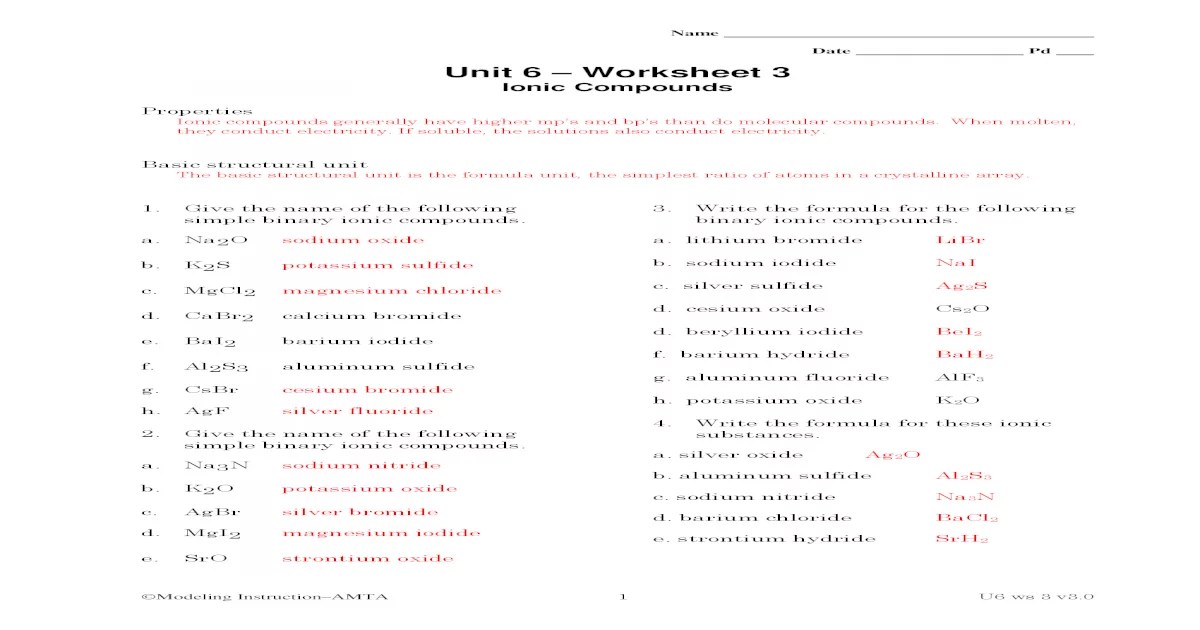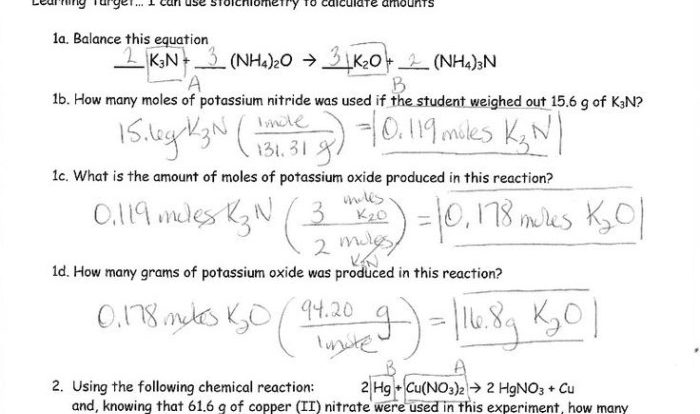Unit 6 worksheet 3 ionic compounds – Unit 6 Worksheet 3: Ionic Compounds delves into the captivating realm of chemistry, where we explore the fascinating world of ionic bonding and its profound impact on the properties and behavior of these unique substances. Prepare to embark on an enlightening journey as we unravel the secrets of ionic compounds, their formation, nomenclature, and chemical reactions.
Ionic compounds, characterized by their strong electrostatic attraction between positively charged cations and negatively charged anions, exhibit distinct physical and chemical properties that set them apart from other compound classes. Join us as we delve into the intricacies of ionic bonding, exploring the factors that govern their formation and stability.
1. Introduction
Ionic compounds are chemical compounds composed of positively charged ions (cations) and negatively charged ions (anions). They are formed when atoms transfer electrons to or from each other, resulting in the formation of ions with opposite charges. The electrostatic attraction between these oppositely charged ions holds the ionic compound together.
Ionic bonding is a type of chemical bond that involves the complete transfer of electrons from one atom to another. The atom that loses electrons becomes a positively charged ion, while the atom that gains electrons becomes a negatively charged ion.
The resulting ions are attracted to each other by their opposite charges, forming an ionic compound.
Examples of ionic compounds include sodium chloride (NaCl), potassium chloride (KCl), and calcium fluoride (CaF 2).
2. Properties of Ionic Compounds
Physical Properties
Ionic compounds are typically solids at room temperature. They have high melting points and boiling points due to the strong electrostatic forces between the ions. Ionic compounds are also generally soluble in water, forming ions in solution.
Chemical Properties
Ionic compounds are generally reactive, especially in aqueous solutions. They can undergo a variety of chemical reactions, including precipitation reactions, acid-base reactions, and redox reactions. Ionic compounds are also good conductors of electricity when dissolved in water or melted.
| Property | Ionic Compounds | Covalent Compounds | Molecular Compounds |
|---|---|---|---|
| Physical State | Solid | Solid, liquid, or gas | Gas |
| Melting Point | High | Low to moderate | Very low |
| Boiling Point | High | Low to moderate | Very low |
| Solubility in Water | Generally soluble | Insoluble | Insoluble |
| Electrical Conductivity | Good (when dissolved or melted) | Poor | Poor |
3. Nomenclature of Ionic Compounds

The rules for naming ionic compounds are based on the charges of the ions involved. The name of the cation is written first, followed by the name of the anion. The charge of the cation is indicated by a Roman numeral in parentheses after the cation name.
The charge of the anion is indicated by the suffix “-ide”.
For example, the ionic compound NaCl is named sodium chloride. The sodium ion has a charge of +1, and the chloride ion has a charge of -1. The name of the ionic compound CaF 2is calcium fluoride. The calcium ion has a charge of +2, and the fluoride ion has a charge of -1.
| Cation Charge | Suffix |
|---|---|
| +1 | -ous |
| +2 | -ic |
| +3 | -ic |
| +4 | -ous |
| +5 | -ic |
| +6 | -ous |
| +7 | -ic |
4. Writing Formulas for Ionic Compounds: Unit 6 Worksheet 3 Ionic Compounds
To write the formula for an ionic compound, you must first determine the charges of the ions involved. The charges of the ions can be determined by using the periodic table or by using the rules for naming ionic compounds.
Once you know the charges of the ions, you can write the formula for the ionic compound by combining the symbols of the ions in a way that balances the charges. For example, the formula for sodium chloride is NaCl.
The sodium ion has a charge of +1, and the chloride ion has a charge of -1. The charges of the ions balance each other out, so the formula for sodium chloride is NaCl.
- Determine the charges of the ions involved.
- Combine the symbols of the ions in a way that balances the charges.
- Write the formula for the ionic compound.
Here are some practice problems for writing ionic compound formulas:
- Write the formula for potassium oxide.
- Write the formula for magnesium chloride.
- Write the formula for aluminum fluoride.
5. Chemical Reactions Involving Ionic Compounds

Types of Chemical Reactions
Ionic compounds can undergo a variety of chemical reactions, including precipitation reactions, acid-base reactions, and redox reactions.
- Precipitation reactionsoccur when two ionic compounds in solution react to form a solid precipitate.
- Acid-base reactionsoccur when an acid and a base react to form a salt and water.
- Redox reactionsoccur when one or more atoms in a compound undergo a change in oxidation state.
Examples of Chemical Reactions, Unit 6 worksheet 3 ionic compounds
Here are some examples of chemical reactions involving ionic compounds:
- Precipitation reaction:NaCl + AgNO 3→ AgCl↓ + NaNO 3
- Acid-base reaction:NaOH + HCl → NaCl + H 2O
- Redox reaction:2Fe + 3Cl 2→ 2FeCl 3
Predicting the Products of Chemical Reactions
To predict the products of a chemical reaction involving ionic compounds, you can use the following steps:
- Identify the reactants and their charges.
- Determine the type of chemical reaction that is occurring.
- Use the rules of chemical reactions to predict the products.
Frequently Asked Questions
What are ionic compounds?
Ionic compounds are formed when a metal loses one or more electrons to a nonmetal, resulting in the formation of positively charged cations and negatively charged anions.
How do you name ionic compounds?
Ionic compounds are named by first naming the cation, followed by the anion. The name of the cation typically ends in “-ium,” while the name of the anion typically ends in “-ide.”
What are the properties of ionic compounds?
Ionic compounds are typically hard, brittle, and have high melting and boiling points. They are also good conductors of electricity when dissolved in water or melted.
